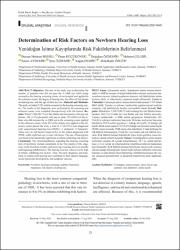| dc.contributor.author | Küçüköner, Ömer | |
| dc.contributor.author | Özgür, Abdulkadir | |
| dc.contributor.author | Mehel, Dursun Mehmet | |
| dc.contributor.author | Özdemir, Doğukan | |
| dc.contributor.author | Çelebi, Mehmet | |
| dc.contributor.author | Aydemir, Samet | |
| dc.contributor.author | Özdemir, Şule | |
| dc.contributor.author | Demir, Kağan | |
| dc.date.accessioned | 2022-07-28T07:36:46Z | |
| dc.date.available | 2022-07-28T07:36:46Z | |
| dc.date.issued | 2021 | en_US |
| dc.identifier.citation | MEHEL D. M,KÜÇÜKÖNER Ö,ÖZDEMİR D,ÇELEBİ M,AYDEMİR S,ÖZDEMİR Ş,DEMİR K,ÖZGÜR A (2021). Determination of Risk Factors on Newborn Hearing Loss. Kulak Burun Boğaz ve Baş Boyun Cerrahisi, 29(1), 13 - 19. Doi: 10.24179/kbbbbc.2020-76445. | en_US |
| dc.identifier.issn | 1300-6525 / 2149-0880 | |
| dc.identifier.uri | https://doi.org/10.24179/kbbbbc.2020-76445 | |
| dc.identifier.uri | https://hdl.handle.net/20.500.12712/33326 | |
| dc.description | Tam Metin / Full Text | en_US |
| dc.description.abstract | The aim of the study was to determine the number of patients who did not pass the A-ABR test while being screened at the hearing screening center of our hospital and applied to the reference center, the degree of hearing loss, the effect of risk factors on hearing loss, and the age of their devices. Material and Methods: The study included 5,552 infants screened at the hearing screening center. The results of the diagnostic tests performed at the screening and reference center were compiled retrospectively with risk factors. Results: While 5,368 (96.7%) of the infants did not present with any risk factors, 184 (3.3%) presented with one or more; 267 (4.8%) of the infants who did not pass the A-ABR test in the screening center applied to the reference center, while 254 of the infants who applied to the reference center passed the tests, a total of 13 (0.23%) were diagnosed with sensorineural hearing loss (SNHL) (1 unilateral, 12 bilateral). There were no risk factors found in five of the infants diagnosed with SNHL, while eight had one or more risk factor. The rate of hearing loss was found to be statistically significant in infants exhibiting risk factors. Conclusion: The recommendations regarding the hearing screening tests of newborns include completion in the first month of life, diagnosis in the first three months, and receiving a hearing aid in six months and beginning rehabilitation. The hearing loss rate is known to be high in infants exhibiting risk factors. Thus, the early diagnosis and treatment of infants with hearing loss contribute to their speech language, social-emotional development, and academic success. | en_US |
| dc.description.abstract | Çalışmanın amacı, hastanemiz işitme tarama merkezinde A-ABR ile taranan ve kalan bebeklerden referans merkezine başvuranların sayısını, işitme kayıplarının derecesi, risk faktörlerinin işitme kaybına etkisi ve cihazlanma yaşlarının tespit edilmesidir. Gereç ve Yöntemler: Çalışmaya işitme tarama merkezinde taranan 5.552 bebek dâhil edildi. Tarama ve referans merkezinde yapılan tanısal testlerin sonuçları, risk faktörleriyle beraber retrospektif olarak derlendi. Bulgular: Bebeklerin 5.368 (%96,7)’inde herhangi bir risk faktörü bulunmazken; 184 (%3,3)’ünde bir veya birden çok risk faktörü mevcuttu. Tarama merkezinde, A-ABR testini geçemeyen bebeklerden 267 (%4,8)’si referans merkezine başvurdu. Referans merkezine başvuran bebeklerin 254’ü testleri geçerken; 1 bebeğe tek taraflı, 12 bebeğe çift taraflı olmak üzere toplam 13 (%0,23) bebeğe sensörinöral işitme kaybı (SNİK) tanısı konuldu. SNİK tanısı alan bebeklerin 5’inde herhangi bir risk faktörü bulunmazken, 8’inde bir veya birden çok risk faktörü mevcuttu. Risk faktörü bulunan bebeklerde işitme kaybı görülme oranı istatistiksel olarak anlamlı bulundu. Sonuç: Yenidoğanların işitme tarama testlerinin yaşamın ilk ayında tamamlanması, ilk 3 ay içinde tanılanması ve 6 ay içinde de cihazlandırılıp rehabilitasyonlarına başlanması önerilmektedir. Risk faktörü bulunan bebeklerde işitme kaybı oranının yüksek olduğu bilinmektedir. İşitme kaybı bulunan bebeklere erken tanı konması ve tedavilerine erken başlanması, bebeklerin konuşma-dil, sosyal, duygusal gelişimlerine ve akademik başarılarına katkı sağlamaktadır. | en_US |
| dc.language.iso | eng | en_US |
| dc.publisher | Kulak Burun Boğaz ve Baş Boyun Cerrahisi Derneği | en_US |
| dc.relation.isversionof | 10.24179/kbbbbc.2020-76445 | en_US |
| dc.rights | info:eu-repo/semantics/openAccess | en_US |
| dc.subject | newborn | en_US |
| dc.subject | hearing screening | en_US |
| dc.subject | auditory brainstem responses | en_US |
| dc.subject | risk factors | en_US |
| dc.subject | hearing loss | en_US |
| dc.subject | yenidoğan | en_US |
| dc.subject | işitme tarama | en_US |
| dc.subject | işitsel beyin sapı yanıtları | en_US |
| dc.subject | risk faktörleri | en_US |
| dc.subject | işitme kaybı | en_US |
| dc.title | Determination of risk factors on newborn hearing loss | en_US |
| dc.title.alternative | Yenidoğan işitme kayıplarında risk faktörlerinin belirlenmesi | en_US |
| dc.type | article | en_US |
| dc.contributor.department | OMÜ, Sağlık Bilimleri Fakültesi, Odyoloji Bölümü | en_US |
| dc.contributor.authorID | 0000-0002-0262-5093 | en_US |
| dc.contributor.authorID | 0000-0002-6155-5988 | en_US |
| dc.contributor.institutionauthor | Küçüköner, Ömer | |
| dc.contributor.institutionauthor | Özgür, Abdulkadir | |
| dc.identifier.volume | 29 | en_US |
| dc.identifier.issue | 1 | en_US |
| dc.identifier.startpage | 13 | en_US |
| dc.identifier.endpage | 19 | en_US |
| dc.relation.journal | Kulak Burun Boğaz ve Baş Boyun Cerrahisi | en_US |
| dc.relation.publicationcategory | Makale - Ulusal Hakemli Dergi - Kurum Öğretim Elemanı | en_US |
















